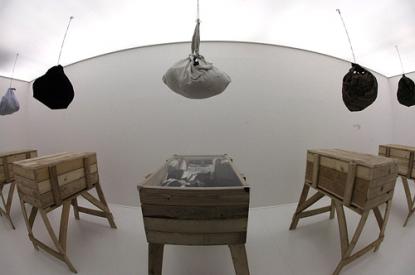2024. May 2. Thursday
House of Terror Museum - Budapest
 |
Address: 1062, Budapest Andrássy út 60.
Phone number: (1) 374-2600
E-mail: muzeum@terrorhaza.hu
Opening hours: Tue-Sun 10.00-18.00
|
The exhibition has closed for visitors.
2006.06.01. - 2006.09.22.
Museum tickets, service costs:
|
Ticket
(valid for the temporary exhibitions, the permanent exhibition is not included )
|
1000 HUF
|
/ capita
|
|
Ticket for adults
|
2000 HUF
|
|
|
Group ticket for adults
(from over 20 people)
|
1500 HUF
|
/ capita
|
|
Ticket for students
(EU citizens from the age of 2 to 26 or with ISIC Card )
|
1000 HUF
|
|
|
Group ticket for students
(from over 20 people)
|
800 HUF
|
/ capita
|
|
Ticket for pensioners
(EU citizens from the age of 62 to 70)
|
1000 HUF
|
|
|
Group ticket for pensioners
(from over 20 people)
|
800 HUF
|
/ capita
|
|
Supplementary fee
(valid for the temporary exhibitions, extra ticket for the permanent exhibition )
|
500 HUF
|
/ capita
|
|
Group guide
(max. 30 people)
|
6000 HUF
|
|
|
Group guide
(2 groups, max. 60 people)
|
8000 HUF
|
|
|
Group guide
(max. 30 people)
|
8000 HUF
|
|
|
Group guide
(2 groups, max. 60 people)
|
15000 HUF
|
|
|
Audio guide
(in English, German)
|
1500 HUF
|
The fate of the Germans after WWII is not a unique phenomena but goes along with the large-scale ethnic regroupings in the first half of the 20th century. During the war the national socialist, communist and west democrat parties all believed in a homogenic ethnic region in Mid-east Europe as they believed the stability of the region could only be solved by that. Where the borders should be and who is moving whom was due to the given circumstances.

The Nazi Germany began to Germanize the invaded areas with great effort from 1939. Between 1939 and 1943 around 700 000 ethnic Germans were moved from East Europe to Germany to where the deported Polish and Jews had once lived.
The Germans in Mid-east Europe were struck with three things. The approaching Red army did not only commit serious atrocities but also dragged the able-bodied men and women by the hundred thousands to the USSR. The Polish, Czechoslovakian and Yugoslavian peace forces terrorized those Germans who stayed at home. The refugees who returned after the war were transported from Czechoslovakia and Poland after the war. Due to the deportations and diving the Germans away, only the population of Romania and Hungary included Germans.
In Hungary, the dilemma of transporting Germans occurred due to financial considerations. The government wished to settle the returning 300 000 refugees at the expense of the Swabians. To do so, the Hungarian government asked for the consent of the powers to deport 200-250 000 'Nazis'. When the deportation of 400-450 000 was allowed, the Hungarian government began to carefully tack. This was also the interest of the nation since the Czechoslovakian and Soviet management often gave voice to their point that the Hungarians from Upper Hungary would have to be settled at the place of the Germans.
During the settling that lasted two and a half years 170 000 Swabians had to leave their homes. With their leaving, the most successful agricultural growers and artisans were lost by the country. We still could not get over this loss.

The Nazi Germany began to Germanize the invaded areas with great effort from 1939. Between 1939 and 1943 around 700 000 ethnic Germans were moved from East Europe to Germany to where the deported Polish and Jews had once lived.
The Germans in Mid-east Europe were struck with three things. The approaching Red army did not only commit serious atrocities but also dragged the able-bodied men and women by the hundred thousands to the USSR. The Polish, Czechoslovakian and Yugoslavian peace forces terrorized those Germans who stayed at home. The refugees who returned after the war were transported from Czechoslovakia and Poland after the war. Due to the deportations and diving the Germans away, only the population of Romania and Hungary included Germans.
In Hungary, the dilemma of transporting Germans occurred due to financial considerations. The government wished to settle the returning 300 000 refugees at the expense of the Swabians. To do so, the Hungarian government asked for the consent of the powers to deport 200-250 000 'Nazis'. When the deportation of 400-450 000 was allowed, the Hungarian government began to carefully tack. This was also the interest of the nation since the Czechoslovakian and Soviet management often gave voice to their point that the Hungarians from Upper Hungary would have to be settled at the place of the Germans.
During the settling that lasted two and a half years 170 000 Swabians had to leave their homes. With their leaving, the most successful agricultural growers and artisans were lost by the country. We still could not get over this loss.
